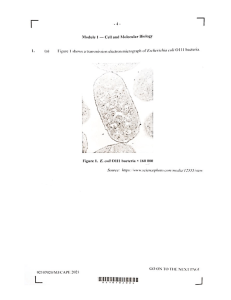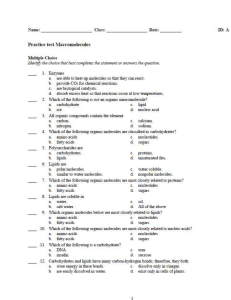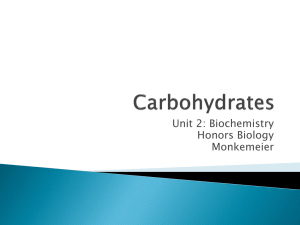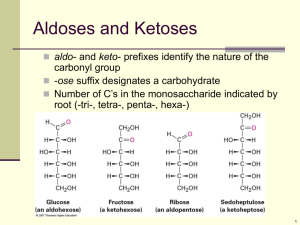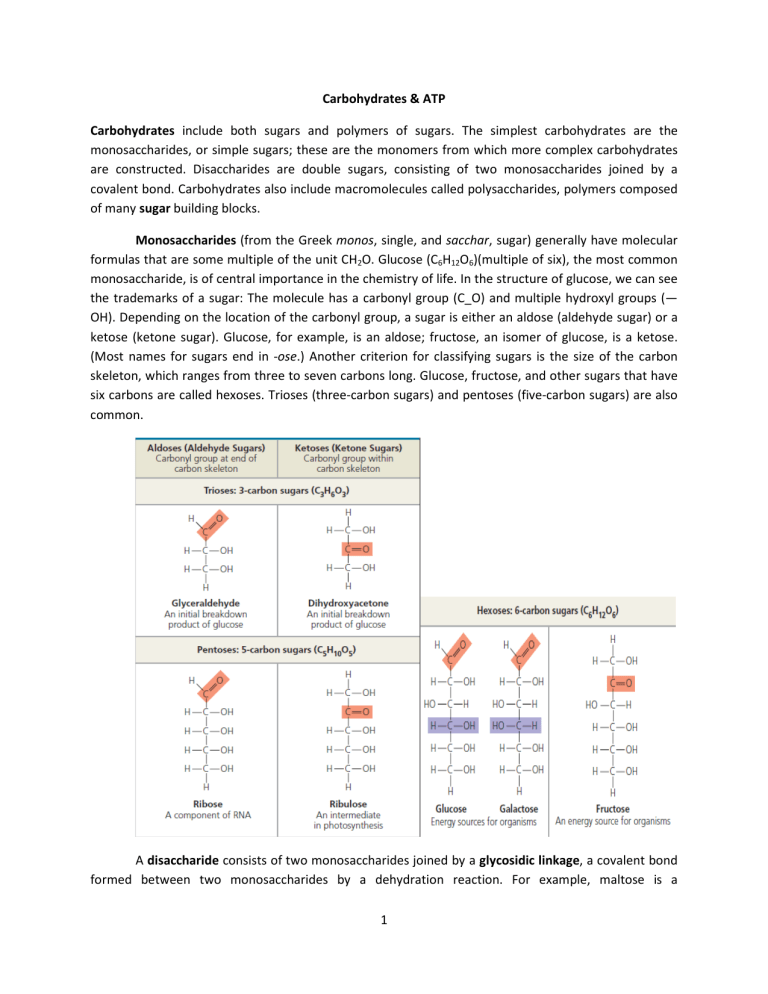
Carbohydrates & ATP Carbohydrates include both sugars and polymers of sugars. The simplest carbohydrates are the monosaccharides, or simple sugars; these are the monomers from which more complex carbohydrates are constructed. Disaccharides are double sugars, consisting of two monosaccharides joined by a covalent bond. Carbohydrates also include macromolecules called polysaccharides, polymers composed of many sugar building blocks. Monosaccharides (from the Greek monos, single, and sacchar, sugar) generally have molecular formulas that are some multiple of the unit CH2O. Glucose (C6H12O6)(multiple of six), the most common monosaccharide, is of central importance in the chemistry of life. In the structure of glucose, we can see the trademarks of a sugar: The molecule has a carbonyl group (C_O) and multiple hydroxyl groups (— OH). Depending on the location of the carbonyl group, a sugar is either an aldose (aldehyde sugar) or a ketose (ketone sugar). Glucose, for example, is an aldose; fructose, an isomer of glucose, is a ketose. (Most names for sugars end in -ose.) Another criterion for classifying sugars is the size of the carbon skeleton, which ranges from three to seven carbons long. Glucose, fructose, and other sugars that have six carbons are called hexoses. Trioses (three-carbon sugars) and pentoses (five-carbon sugars) are also common. A disaccharide consists of two monosaccharides joined by a glycosidic linkage, a covalent bond formed between two monosaccharides by a dehydration reaction. For example, maltose is a 1 disaccharide formed by the linking of two molecules of glucose. Also known as malt sugar, maltose is an ingredient used in brewing beer. The most prevalent disaccharide is sucrose, which is table sugar. Its two monomers are glucose and fructose. Plants generally transport carbohydrates from leaves to roots and other nonphotosynthetic organs in the form of sucrose. Lactose, the sugar present in milk, is another disaccharide, in this case a glucose molecule joined to a galactose molecule. Polysaccharides are macromolecules, polymers with a few hundred to a few thousand monosaccharides joined by glycosidic linkages. Some polysaccharides serve as storage material, hydrolyzed as needed to provide sugar for cells. Other polysaccharides serve as building material for structures that protect the cell or the whole organism. The architecture and function of a polysaccharide are determined by its sugar monomers and by the positions of its glycosidic linkages. Both plants and animals store sugars for later use in the form of storage polysaccharides. Plants store starch, a polymer of glucose monomers, as granules within cellular structures known as plastids, which include chloroplasts. Synthesizing starch enables the plant to stockpile surplus glucose. Because glucose is a major cellular fuel, starch represents stored energy. The sugar can later be withdrawn from this carbohydrate “bank” by hydrolysis, which breaks the bonds between the glucose monomers. Most animals, including humans, also have enzymes that can hydrolyze plant starch, making glucose available 2 as a nutrient for cells. Potato tubers and grains—the fruits of wheat, maize (corn), rice, and other grasses—are the major sources of starch in the human diet. Most of the glucose monomers in starch are joined by 1–4 linkages (number 1 carbon to number 4 carbon), like the glucose units in maltose. The simplest form of starch, amylose, is unbranched. Amylopectin, a more complex starch, is a branched polymer with 1–6 linkages at the branch points. Animals store a polysaccharide called glycogen, a polymer of glucose that is like amylopectin but more extensively branched. Humans and other vertebrates store glycogen mainly in liver and muscle cells. Hydrolysis of glycogen in these cells releases glucose when the demand for sugar increases. Structural Polysaccharides Organisms build strong materials from structural polysaccharides. For example, the polysaccharide called cellulose is a major component of the tough walls that enclose plant cells. On a global scale, plants produce almost 1014 kg (100 billion tons) of cellulose per year; it is the most abundant organic compound on Earth. Like starch, cellulose is a polymer of glucose, but the glycosidic linkages in these two polymers differ. The difference is based on the fact that there are actually two slightly different ring structures for glucose. When glucose forms a ring, the hydroxyl group attached to the number 1 carbon is positioned either below or above the plane of the ring. These two ring forms for glucose are called alpha (α) and beta (β), respectively. In starch, all the glucose monomers are in the α configuration. The glucose monomers of cellulose are all in the β configuration, making every glucose monomer “upside down” with respect to its neighbors. The differing glycosidic linkages in starch and cellulose give the two molecules distinct threedimensional shapes. Whereas certain starch molecules are largely helical, a cellulose molecule is straight. Cellulose is never branched, and some hydroxyl groups on its glucose monomers are free to 3 hydrogen-bond with the hydroxyls of other cellulose molecules lying parallel to it. In plant cell walls, parallel cellulose molecules held together in this way are grouped into units called microfibrils. These cable-like microfibrils are a strong building material for plants and an important substance for humans because cellulose is the major constituent of paper and the only component of cotton. Enzymes that digest starch by hydrolyzing its α linkages are unable to hydrolyze the β linkages of cellulose because of the distinctly different shapes of these two molecules. In fact, few organisms possess enzymes that can digest cellulose. Animals, including humans, do not; the cellulose in our food passes through the digestive tract and is eliminated with the feces. Along the way, the cellulose abrades the wall of the digestive tract and stimulates the lining to secrete mucus, which aids in the smooth passage of food through the tract. Thus, although cellulose is not a nutrient for humans, it is an important part of a healthful diet. Most fresh fruits, vegetables, and whole grains are rich in cellulose. On food packages, “insoluble fiber” refers mainly to cellulose. Some microorganisms can digest cellulose, breaking it down into glucose monomers. A cow harbors cellulose digesting prokaryotes and protists in its stomach. These microbes hydrolyze the cellulose of hay and grass and convert the glucose to other compounds that nourish the cow. Similarly, a termite, which is unable to digest cellulose by itself, has prokaryotes or protists living in its gut that can make a meal of wood. Adenosine triphosphate (ATP) ATP is an important source of energy for cellular processes. ATP consists of an organic molecule called adenosine attached to a string of three phosphate groups: Where three phosphates are present in series, as in ATP, one phosphate may be split off as a result of a reaction with water. This inorganic phosphate ion, HOPO32-, is often referred as a phosphate group. 4 While losing this group, it releases energy equivalent to 7.3 Kcal/mol. Energy required for most of the chemical reactions in the cell is used by releasing phosphate group. Energy is also stored in the form of ATP by the cell. 5

